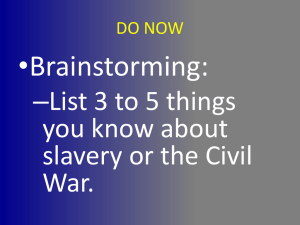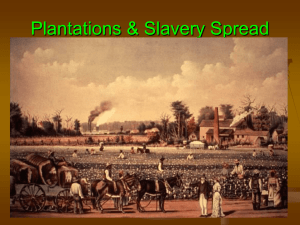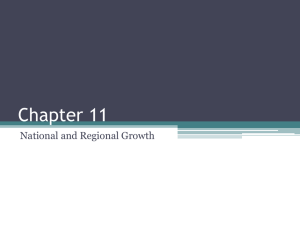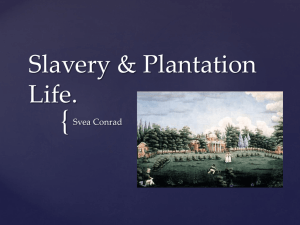Nat Turner
advertisement
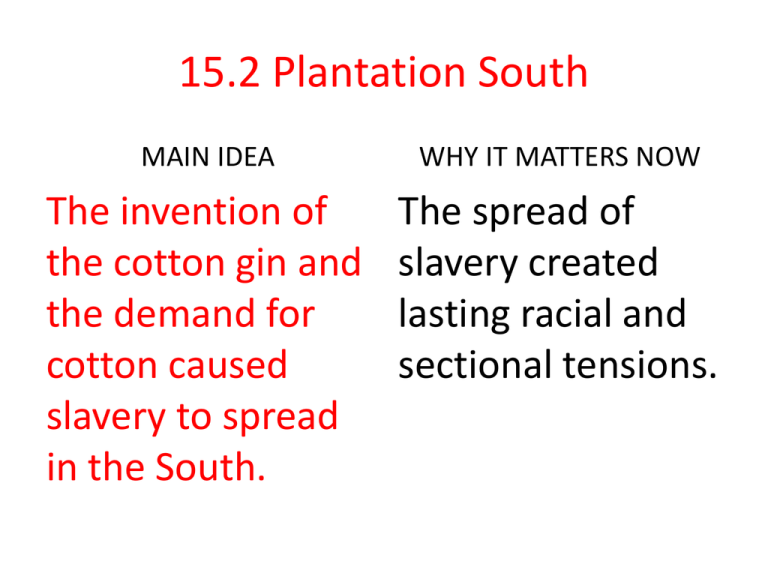
15.2 Plantation South MAIN IDEA WHY IT MATTERS NOW The invention of the cotton gin and the demand for cotton caused slavery to spread in the South. The spread of slavery created lasting racial and sectional tensions. CA. Standards • 8.7.1 Describe the development of the agrarian economy in the South, identify the locations of the cotton-producing states, and discuss the significance of cotton and the cotton gin. • 8.7.2 Trace the origins and the development of slavery; its effects on black Americans and on the region’s political, social, religious, economic, and cultural development; and identify the strategies that were tried to both overturn and preserve it (e.g., through the writing and historical document on Nat Turner, Denmark Vesey). Daily Guided Questions 1. How did cotton affect the social and economic life of the South? 2. How was life different for plantations slaves, city slaves and free blacks in the South? 3. What were some of the ways enslaved people resisted slavery? Silent Read • • • • • Read silently pages 270-274. Everything on those pages. Read the Vocabulary Builders. Read the Main Ideas. Look and read over the graphs and pictures. • Read over the Check Your Progress. The Cotton Kingdom • Eli Whitney invented the use of interchangeable parts, what was the other invention of his that revolutionized the cotton industry? How did it work? Eli Whitney invented the _______and it… • Eli Whitney invented the Cotton Gin and it worked by removing the seeds from the cotton fiber. Cont. • How did cotton affect the social and economic life of the South? Cotton affected the social and economic life of the South by… • Cotton affected the social and economic life of the South by increasing the need for slave labor and making large plantation owners wealthy. North and Slavery • Who benefitted from cotton production in the North? In the North, the people that benefitted from cotton production… • In the North, the people that benefitted from cotton production were textiles owners, bankers, and ship owners. Southern Life • About how many southern farmers did not own slaves? • More then half of the southern farmers didn’t own slaves. • What did they farm instead? • These farmers grew other crops or raised farm animals. • What do you notice about the graphs on page 271? • With a greater demand for cotton, so the demand for slave labor. Defending Slavery • Why did most southern white people support slavery although many didn’t own slaves? Although many southern whites didn’t own slaves they support it because… …they feared a violent uprisings. Cont. • How did the supporters of slavery compare it to the factory system in the North, saying it was more humane? • Supporters of slavery defended slavery, saying… …slaves didn’t have to worry about unemployment, homelessness, or starvation. African Americans in the South • About what percentage of slaves were free and what was one way they could obtain their freedom? About ___% were free and one way they could obtain their freedom was by____. About 6% were free and one way they could obtain their freedom was by buying their freedom. Cont. • Although free, free southern blacks could not do what? Freed African-Americans could not… …go to school, serve on juries, or testify against whites in courts. • Why were free blacks in the south discouraged from traveling? Free blacks were discouraged from traveling because… …they could be captured by slave catchers and sold into slavery. Life Under Slavery • What were slave codes? Slave codes were… -Couldn’t gather in large groups -Free blacks couldn’t own a gun -Slaves were not allowed to read or write Cont. • What were some of the jobs of slaves and their punishments? -Heavy farm labor. -House servants and cooks. -Whippings, branding, etc. Cont. • What were spirituals? Spirituals were… …religious folk songs that blended biblical themes with the realities of slavery. -Compared themselves to the ancient Hebrews. Resistance to Slavery • Denmark Vesey created a plan to attack Charleston S.C. • Slave rebellion. -Gathered guns and ammunition. • Betrayed by other slaves. Cont. • What were some of the ways slaves resisted slavery? Some ways slaves resisted slavery was by… …working slowly, pretended not to understand directions, broken farm equipment, or run away. Nat Turner • Who was Nat Turner and what did he do? • Led a slave rebellion in 1831, killing 60 whites. Primary Source and Questions pg. 629 • Read the primary source, Twelve Years a Slave by Solomon Northrup, on page 629. • Read everything on the page and answer the three questions at the bottom. Study Guide pg. 120 • Copy and complete the study guide on page 120. • Use your notes and textbook pages 270-274 to complete the study guide. ANSWERS 1. Eliza wanted the slave owner to not just buy her son, but the whole family. She tried by begging and promising to be the most faithful slave ever. 2. The slave dealer responded by threating to beat her. 3. Answers may vary, but most readers were effected emotionally, by the idea of breaking up families and cruelty of slave owners/dealers. Essential Questions 1. Why did Americans take different paths (North, South, and West) in the early 1800’s? 2. How did the new technology of the Industrial Revolution change the way Americans lived? (pg. 258-261) 3. How did urbanization, technology, and social change affect the North? (pg. 264-269) 4. What obstacles did blacks face in the North? (pg. 269) 5. How were northern textile mills and Southern cotton plantations linked? What key invention deepened this connection? (pg. 270) 6. How was life different for plantations slaves, city slaves and free blacks in the South? (pg. 272-274) 7. What were some of the ways enslaved people resisted slavery? (pg. 274)



